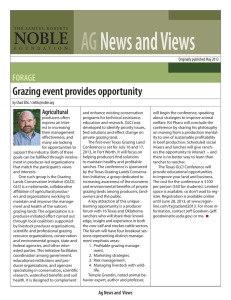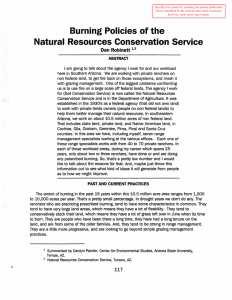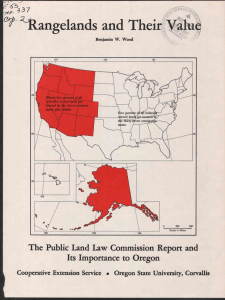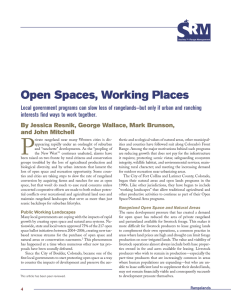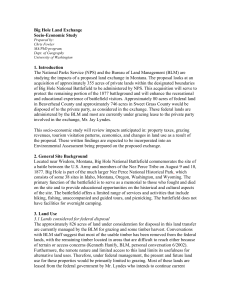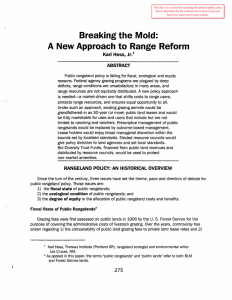Public Lands and Political Meaning: Ranchers, the Government, and the Property
advertisement
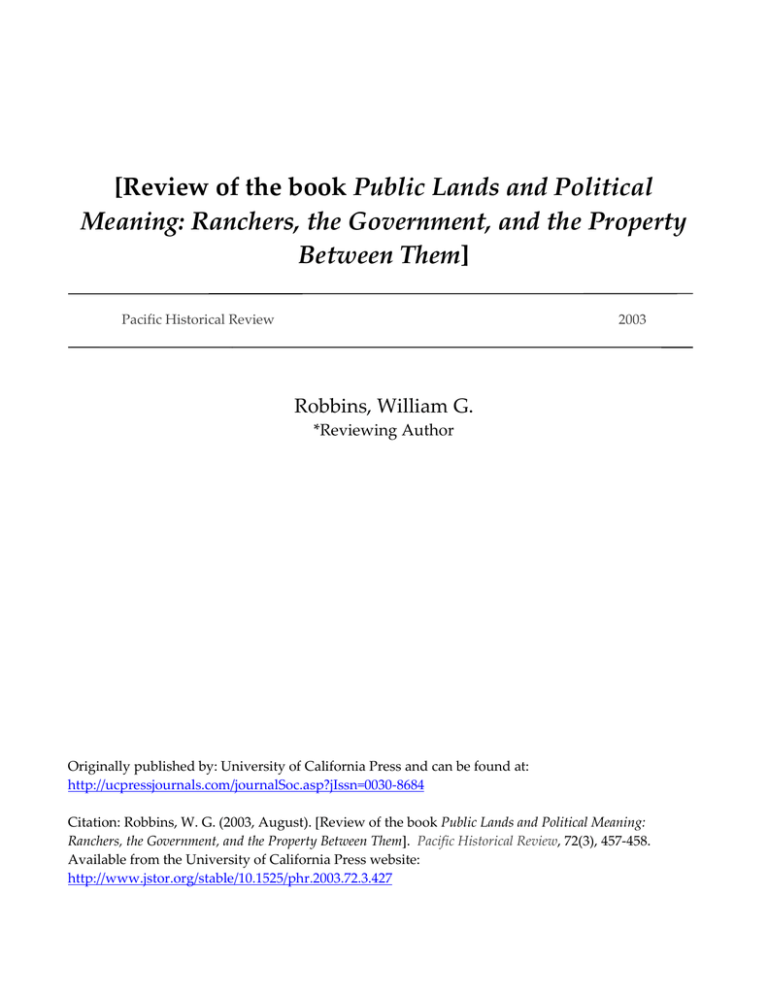
[Review of the book Public Lands and Political Meaning: Ranchers, the Government, and the Property Between Them] Pacific Historical Review 2003 Robbins, William G. *Reviewing Author Originally published by: University of California Press and can be found at: http://ucpressjournals.com/journalSoc.asp?jIssn=0030-8684 Citation: Robbins, W. G. (2003, August). [Review of the book Public Lands and Political Meaning: Ranchers, the Government, and the Property Between Them]. Pacific Historical Review, 72(3), 457-458. Available from the University of California Press website: http://www.jstor.org/stable/10.1525/phr.2003.72.3.427 Reviews of Books vocal in their opposition than environmentalists. Despite this outcry, Pearson argues that environmentalists had little effect on the legislative process. As evidence of this, he points to the fact that the proposal appeared to be on the verge of passing the House of Representatives in 1966 (at a time when the outcry against the dams was at its highest) only to be scuttled at the last minute. Pearson claims that California water interests sabotaged the bill, but other scholars argue that the billÕs demise was at least partly due to environmental pressure. When, two years later, Congress did pass a Central Arizona Project billÑ minus the two dams Ñ it was quickly hailed by environmentalists and historians as a victory for the Sierra Club and a testament to the emerging political strength of the environmental movement. Pearson criticizes this instant analysis, which has largely been accepted as fact in the subsequent literature, noting that the original promoter of this viewpoint was historian Roderick Nash, an active member of the Sierra Club during the Grand Canyon campaign. Thoroughly researched, PearsonÕs book provides an excellent look at both the history of this controversy and its historiography as well. Utah State University STEPHEN C. STURGEON Public Lands and Political Meaning: Ranchers, the Government, and the Property Between Them . By Karen R. Merrill. (Berkeley, University of California Press, 2002. xix 1 274 pp. $50) One of the great ambiguities in federal oversight of federal lands in the American West during the last century has been the tempestuous debate over the nature of access to grazing on the public domain. Karen MerrillÕs skillfully crafted Public Lands and Political Meaning contends that differing and complex meanings about the nature of private property were at the center of those discussions. In six evenly paced chapters, she declares that shifting interpretations about relations of property have deÞned the conßict between the federal government and graziers on the public lands. In brief, Merrill argues that federal authorities, public land ranchers, and major court decisions were bound in symbiotic structural relationships over the meaning of private property. The government ultimately vested its regulatory power in private property rights, and those who took grazing leases on federal lands did so as well. That conundrum follows us into the twenty-Þrst century. The critical piece of legislation that has shaped the political debates of the last seventy years has been the Taylor Grazing Act, the 457 458 Paci c Historical Review genius of ColoradoÕs senior congressman, Edward T. Taylor, a former proponent of the Homestead ideal who shifted his views in the 1930s to embrace the idea of institutionalizing long-term federal grazing leases. Embodied in the 1934 legislation were ambiguities denying leaseholders Òany right, title, interest, or estate in or to the landsÓ and, at the same time, guaranteeing that no permittee Òshall be denied the renewal of such permit, if such denial will impair the value of the grazing permit to the permitteeÓ (p. 141). Most important, the Taylor legislation enacted a quasi-property rights claim to public grazing lands that has withstood all challenges to the present day. Despite the progressive political positions of interior secretaries from Harold Ickes to Bruce Babbitt, the essential structure of the Taylor legislation has withstood challenges for nearly seventy years. The divisive and shifting historical context of public landmanagement politics has contributed to persisting debates over the proper use and control of federal grazing lands. Central to those discussionsÑby both the federal government and its client lessees Ñhas been the nature of the property attachments to grazing leases. Politicians and policymakers also struggled through the 1920s with a conßicted statesÕ rights movement that culminated with the publication in 1932 of Charles WintersÕs classic, Four Hundred Million Acres. While state sovereignty was the centerpiece to WintersÕs critique, the future would prove again and again that the great hope of turning the federal grazing estate over to the states would never be realized. This is a sometimes stylistically ßawed but signiÞcant and important book that deserves a wide reading among scholars of western Americana, public land managers, elected ofÞcials, and others concerned with the stewardship of our public rangelands. Merrill reminds readers that the close cooperation between the federal government and ranchers (and the consequent ecological problems with grazing lands) is the product of a century of struggle over the conßicted meaning of property attachments to the public range. Oregon State University WILLIAM G. ROBBINS Science in the American Southwest: A Topical Histor y. By George E. Webb. (Tucson, University of Arizona Press. 2002. xxi 1 271 pp. $48) This is a useful, if rather one-sided, history of science in the American Southwest, a region the author deÞnes as Arizona, New Mexico, and West Texas. Readers familiar with Gerald D. NashÕs
